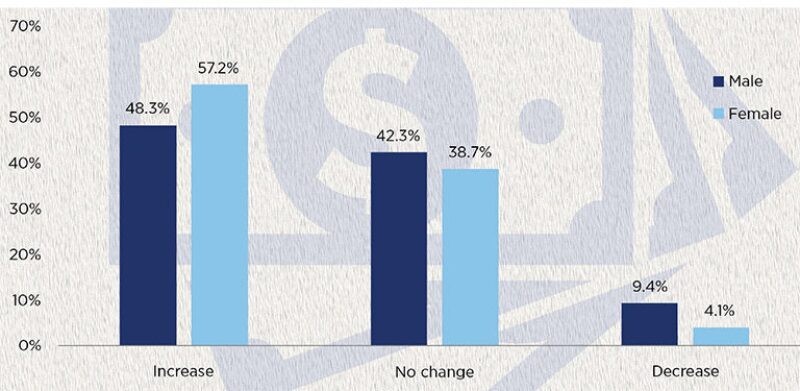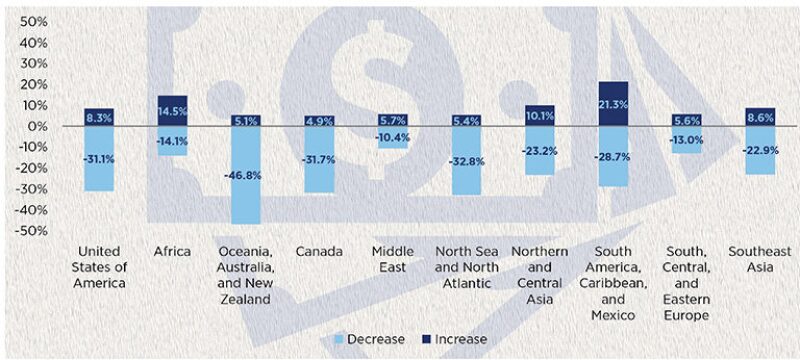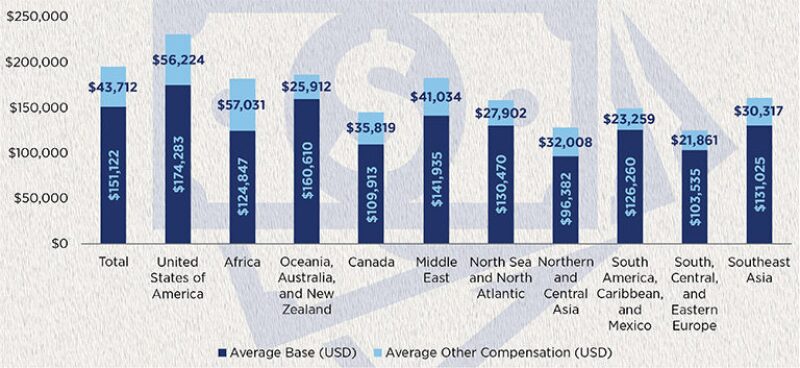Petroleum industry professionals re-ported average total compensation of $194,649 in 2017, an increase from 2016 but still lower than the average salaries before the oil price downturn that began in 2014. Average compensation was $185,001 in 2016, $206,020 in 2015, and $214,328 in 2014. Compared with 2016, mean base pay, other compensation, and total compensation all rose in 2017.
Base pay in 2017 ($151,122) increased from last year ($143,006 in 2016) while other compensation, including bonuses, increased for the first time since 2013 ($64,000). Average other compensation for 2017 ($43,712) is up slightly from last year ($41,995) but lower than previous years.
The number of professionals receiving a car allowance continues to decline. In 2017, the number of respondents who reported receiving a car allowance was 23.2%. In previous years, this number has ranged from about one-fourth to as high as one-third of respondents in the salary survey (24.6% in 2016; 26.3% in 2015; 28.4% in 2014; 31% in 2013).
The average age of energy and petroleum professionals participating in the survey was 43 years old, consistent with the past 6 years. The level of experience that professionals have in the industry remained consistent with recent years, with the average at 18 years. Experience varied by gender with male professionals having an average of 19.4 years and females an average of 12.7.
The global mean for total compensation increased in every job category from 2016 to 2017. The most marked increases are from the top-tier professionals in the South America, Caribbean, and Mexico; South, Central, and Eastern Europe; and Southeast Asia regions.
The higher job category tiers reported the highest number of increases in total compensation. Year over year, eight of 10 regions saw increases in total compensation at the executive/top management level. The amount of the increases were also substantially larger. However, declines in compensation from 2016 to 2017 occurred at the professional/individual contributor and technician/specialist/support staff levels.
Impact of Gender
Base pay and total compensation continues to vary by gender, with male professionals earning more than their female counterparts overall. But female supervisor/superintendent/lead professionals reported larger increases and smaller decreases than males. Male professionals at the executive/top management level reported increases in both base pay and total compensation. About half of male respondents (48.3%) and nearly three-fifths of female respondents (57.2%) reported an increase in base pay.

Change in Base Pay by Region
Overall, nearly half (49.7%) of respondents reported a pay increase during the period of June 2016 to June 2017, a significant increase compared with last year (35.9% in 2016). However, the increase in average base pay for 2017 was still lower than the figures reported in 2015.
Respondents from the US, Canada, and South, Central, and Eastern Europe regions reported the largest year over year changes, with the US up 22.6%; Canada up 15.2%; and the South, Central, and Eastern Europe region up 21.6%. Notable changes in decreases were seen in some regions. Only two regions reported a higher average decrease in base pay for 2017: the South America, Caribbean, and Mexico region, which has experienced a volatile economy over the past year, and the Oceania, Australia, and New Zealand region.

The overall trends in change in average base pay by region remained consistent with the trends seen in 2016. There were a few notable changes over the past year. The Canada region saw a sizeable change in decrease of average base pay (–14.0%). The Northern and Central Asia (–8.5%) and Oceania, Australia, and New Zealand (–31.9%) regions saw almost as much change in their respective base pay decreases since 2016.
Increases in base pay were less drastic year over year, with the highest increase in base pay seen in the Africa region (8.2% in 2016). The overwhelming majority (90.6% of respondents with Africa as their base region) reported increases in their base pay over the past year.
For More Information
This summary represents a sample of current compensation in the industry. The 2017 SPE Highlight Report is available at www.spe.org/industry/oil-and-gas-salary-survey. A detailed full report containing charts and descriptive statistics of trends and more information on the jobs, geographies, and employer types is available for purchase at the SPE Bookstore. The data set is included in the purchase of the full report and is also available for purchase separately for individual analysis and localization of data.
Questions regarding the survey can be addressed to speresearch@spe.org.

